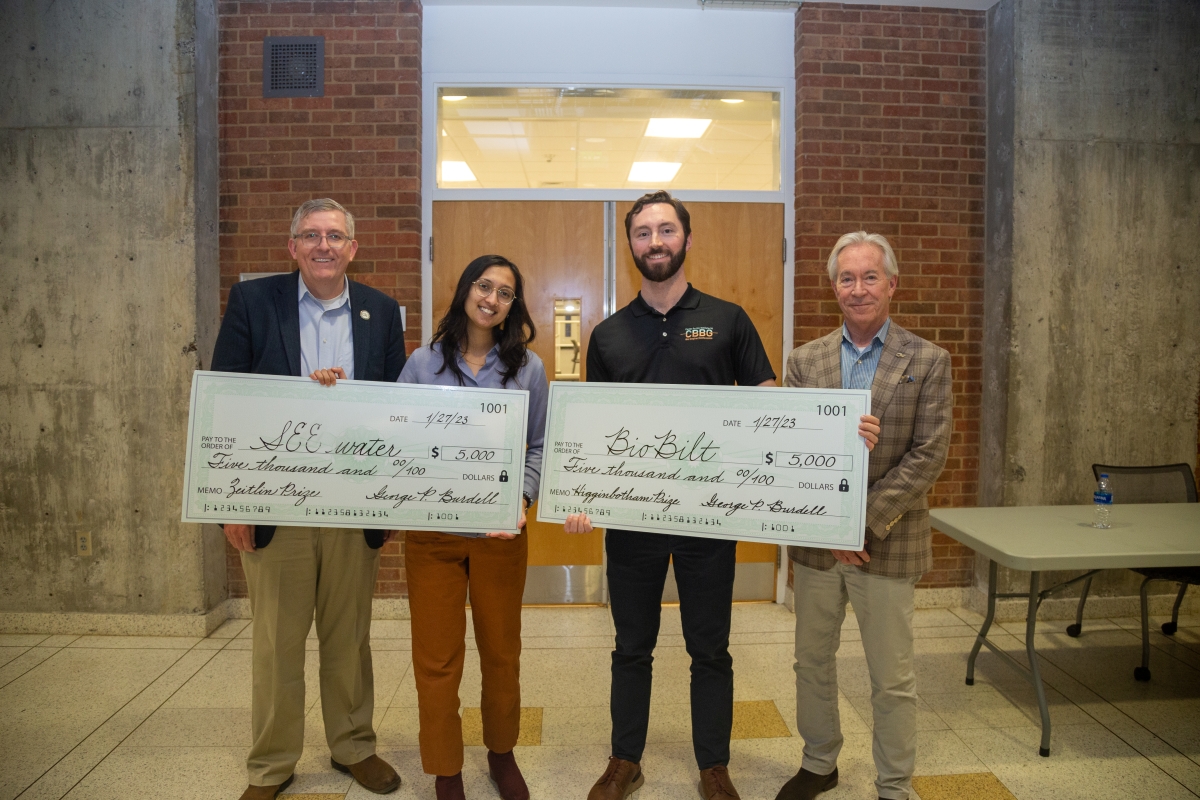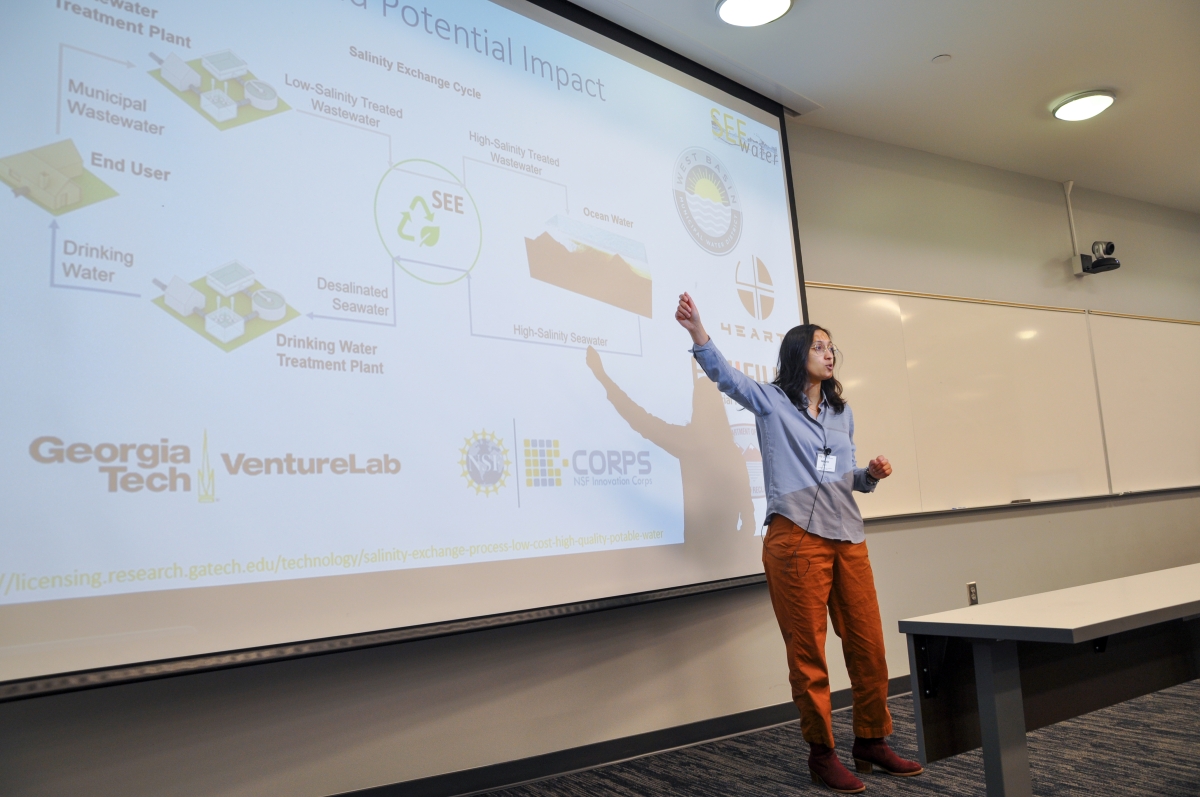
Left to right: School Chair Don Webster, Zeitlin Award winner Mo Jarin, Higginbotham Award winner John Huntoon, and Bill Higginbotham, CE 76. (Photo by Amelia Neumeister)
Two CEE students walked away with $5,000 prizes at the 2023 Entrepreneurial Impact Competition after impressing a panel of judges with their ideas for an improved ground anchor design and technology to desalinate sea water for drinking.
The Entrepreneurial Impact Competition was established in 2020 as a way to encourage a culture of entrepreneurship among CEE students, with the first two events held virtually due to Covid-19 safety precautions.
Alumnus Bill Higginbotham, CE 76, is a serial entrepreneur and instructor who teaches Innovation and Entrepreneurship in CEE Systems. He pitched the idea for the competition and donated the money to fund one of the prizes.
Higginbotham said it was especially rewarding to attend this year’s competition for the first time in person.
“I brought his idea to [School Chair Don Webster] a few years ago trying to come up with something that would drive entrepreneurship down to the student level where it’s tangible,” Higginbotham said. “I’ve been thwarted for the last two years because the Zoom call just does not work. You really need to see the live presentation. I’m thrilled that we finally got to see it and I’m thrilled that this is one of many opportunities to get the ultimate motivator, money, down to the hands of these bright young students.”
Following an open call for submissions in the Fall 2022 semester, four finalists were selected to participate in the Jan. 27 competition.
During the event, each of the finalists gave a five-minute verbal pitch of their projects to a panel of expert judges and a live audience, followed by 10 minutes of questions from the judges. After all the presentations, the judges deliberated and selected the top proposals to win the Higginbotham Entrepreneurship Award and the Zeitlin Innovation Award, worth $5,000 each.
PhD student John Huntoon was selected to win the Higginbotham Entrepreneurship Award, which recognizes a more developed project with an emphasis on bringing the concept to market.
Huntoon’s startup, BioBilt Infrastructure Systems, LLC, promotes a root-inspired ground anchor that is designed to mimic the way that roots stabilize plants in the soil.
Huntoon explained that his root-inspired ground anchor (RIGA) is an example of bio-inspired design, in which engineers look to nature to find inspiration for more efficient designs and apply them to human infrastructure problems.
“We want to use the existing materials and methods that we use to construct conventional ground anchors today, but modify them to make it more efficient,” Huntoon said. “We did that by incorporating the geometry of fibrous plant roots.”

John Huntoon demonstrates his root-inspired ground anchor in front of a large screen. (Photo by Melissa Fralick)
The design of the RIGA results on average in a 30 percent reduction in both materials and installation, providing potentially meaningful cost savings for geotechnical specialty contractors.
“What we find is that these companies operate in an environment where they are competing almost exclusively on the time-to-install dimension,” Huntoon said. “They’re also operating in a place where their labor and equipment costs are much higher than their material costs. And so the 30 percent reduction in time is extremely valuable for the geotechnical specialty contractors.”

Zeitlin Innovation Award winner, Mo Jarin, presents her concept SEE Water to the judges. (Photo by Melissa Fralick)
Mo Jarin, an environmental engineering PhD student, was selected to win the Zeitlin Innovation Award with her concept called SEE water. The Zeitlin Innovation Award emphasizes creativity and the merits of a project at any stage of development.
SEE water addresses the challenge of providing clean, safe and affordable drinking water to a growing global population.
“Our freshwater resources are rapidly diminishing and in order to harness the majority of Earth's water supply—seawater—we need to take the salt out through desalination,” Jarin said.
There are several desalinization processes currently available, but all require high energy consumption, preventing more widescale adoption. Another option for providing more drinking water is recycling treated waste water back into the water supply. While safe, this practice faces a major obstacle from public perception.
Jarin’s solution bridges the challenges associated with both methods through a process called Salinity Exchange through Electrodialysis, or SEE. This method would reuse treated wastewater to help desalinate seawater without ever mixing the two.
“We have salts from high salinity seawater that get transferred to low salinity-treated wastewater until the salt concentrations approximately switch, resulting in desalinated seawater that can be further treated for potable use, and a high salinity treated waste water that can be discharged safely to the ocean,” Jarin said.
Jarin explained that there are several advantages to this method. First, it's energy efficient due to the natural concentration gradient between the two feeds. Second, it doesn’t generate brine, so there are no harmful ecological or environmental impacts. And third, it helps with the matter of public acceptance.
“Drinking desalinated seawater is going to be so much more appealing than drinking treated waste water,” Jarin said.
